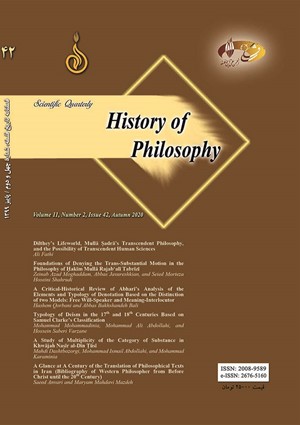-
-
List of Articles
-
Open Access Article
1 - Editors Note
Hossein Kalbasi Ashtari -
Open Access Article
2 - Dilthey’s Lifeworld, Mullā Ṣadrā’s Transcendent Philosophy, and the Possibility of Transcendent Human Sciences
Ali Fathi -
Open Access Article
3 - Foundations of Denying the Trans-Substantial Motion in the Philosophy of Ḥakīm Mullā Rajab‘alī Tabrīzī
Zeinab Azad Moghaddam Abbas Javareshkian Seied Morteza Hoseini Shahrudi -
Open Access Article
4 - A Critical-Historical Review of Abharī’s Analysis of the Elements and Typology of Denotation Based on the Distinction of two Models: Free Will-Speaker and Meaning-Interlocutor
Hashem Ghorbani Abbas Bakhshandeh Bali -
Open Access Article
5 - Typology of Deism in the 17th and 18th Centuries Based on Samuel Clarke’s Classification
Mohammad Mohamadinia Mohamad Ali Abdollahi Hossein Saberi -
Open Access Article
6 - A Study of Multiplicity of the Category of Substance in Khwājah Naṣīr al-Dīn Ṭūsī
Mahdi Dasht Bozorgi Mohammad Ismail Abdollahi Mohammad Karaminia -
Open Access Article
7 - A Glance at A Century of the Translation of Philosophical Texts in Iran (Bibliography of Western Philosopher from Before Christ until the 20th Century)
Saeed Anvari Maryam Mahdavi Mazdeh
-
The rights to this website are owned by the Raimag Press Management System.
Copyright © 2017-2025







